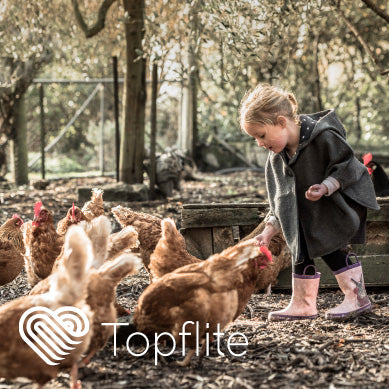Scratch & Lay
$52.50
Please select all options.
Through careful research and advice from poultry nutrition experts, we formulated a premium mix for backyard chooks with a combination of grains, pulses, seeds, grit and high-protein pellets that provides optimal nutrition.
And they love it! The variety of ingredients in Scratch & Lay provides endless fodder for foraging, and keeps chickens busy, happy and well-fed.
We stand by the sources of the ingredients – quite literally, in fact. Scratch & Lay is mixed in Oamaru with canary seed, sunflower seed, wheat, barley and blue peas from our growers down the road. Add kibbled maize from selected NZ farms, Southland-grown oats, Bluff oyster shell grit, high-protein pellets and your chooks have a mix of real homemade goodness at their feet.
- Meets the 16% protein requirement for laying chickens
- Free of ruminant protein; contains soy-based pellets
- New Zealand-grown grains, seeds and pulses
- Recyclable paper sack (20kg only)
- The best in the bok-bok-bok business for laying hens
Feeding Guide: We recommend supplying around 150g per chicken, per day. Always make fresh water and additional oyster shell grit available. Feed fresh greens and food scraps for extra vitamins and minerals. To keep Scratch & Lay fresh, it’s best to only store around three months’ supply at a time.
Note: 20kg Scratch & Lay now comes in recyclable paper sacks. We recommend transferring the feed into a large, lidded bin to keep it fresh and safe from rodents.
Ingredients: High protein pellets (soya bean meal, peas, wheat by-products (broll) and vegetable oil), barley, kibbled maize, wheat, whole oats, kibbled green peas, canary seed, oyster grit, NZ sunflower.
Analysis: Protein: 16.5%, fat: 3.8%, fibre: 6.4%, calcium: 1.6%, reactive lys mg/100mg: 0.75%
FAQs
Is Scratch & Lay suitable as a complete diet for my chickens?
Close, but not quite. Because Scratch & Lay is a mix of whole grains and seeds, which have naturally occurring variances in their vitamin and mineral profiles, it is not suitable as a complete diet for hens. To tick all the dietary boxes, we recommend supplementing Scratch & Lay with oyster shell grit, fresh greens and food scraps to boost their intake of calcium and other essential vitamins and minerals. Ideally your chickens will also have the freedom to roam and forage for natural protein sources like insects, and soak up the sunshine to keep them in good health.
How many chickens should I get?
How many is too many? This somewhat depends on their roaming space, whether your coop can comfortably cater to them, and whether you can afford to look after them correctly. However before you start planning for a new (or bigger) flock it’s important to check the regulations with your local council. There are different rules for how many you are allowed (and other key details) depending on where you live.
What are the most important things to have in a chicken coop?
Your chooks will need dark nesting boxes, some solid perches for roosting and obviously somewhere to shelter from the elements. Chickens like to sleep close together so you don’t need to go over the top – something like 20cms of perch space will be enough. Nest boxes should be approximately 30 square cm.
How much should I feed each chicken?
For the average brown shaver (around 2kg) feed 120-130g of food each day. Extras, such as scraps or mealworms should be no more than 5-10g per day. For smaller heritage species, it's best to talk to a breeder.
Does any of your chicken feed contain extra hormones?
No it does not.
What kind of treats do chickens like?
They go crazy for mealworms! Scatter a few on the ground to encourage natural foraging behaviour. The high protein content also helps to boost egg productivity.
How often should I feed chickens treats?
Treats should make up, at most, 5-10% of their daily diet.
How long does chicken feed last when stored?
If stored correctly in a dry environment our feed should last approximately 4-5 months. Always check your feed for mould or bugs before feeding however.
Where do Topflite’s chicken feed ingredients come from?
Most of our ingredients are grown at our South Island farms, a lot of it harvested from the rich and fertile soils of our hometown, Ōamaru.
Does Topflite chicken feed contain ruminant protein?
The only product that contains ruminant protein is our Classic Layer Pellets. The protein content of our other feeds is vegetable based.
Related Posts

Your Quick Care Guide: Chickens
July 17, 2023








